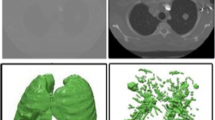Abstract
In this study, we present preliminary data on the effect of automated 3D image alignment on the time to arrive at a decision about an imaging finding, the agreement of multiple of multiple observers, the prevalence of comparison examinations, and technical success rates for the image alignment algorithm. We found that automated image alignment reduced the average time to make a decision by 25% for cases where the structures are rigid, and when the scanning protocol is similar. For cases where these are not true, there is little or no benefit. In our practice, 54% of cases had prior examinations that could be automatically aligned. The overall benefit seen in our department for highly similar exams might be 20% for neuro and 10% for body; the benefit seen in other practices is likely to vary based on scanning practices and prevalence of prior examinations.



Similar content being viewed by others
References
Chen CT: Radiologic image registration: old skills and new tools. Acad Radiol 10:239–241, 2003
Studholme C, Hill DLG, Hawkes DJ: Automated three-dimensional registration of magnetic resonance and positron emission tomography brain images by multiresolution optimization of voxel similarity measures. Med Phys 24:25–35, 1997
Woods RP, Mazziotta JC, Cherry SR: MRI-PET registration with automated algorithm. J Comput Assist Tomogr 17:536–546, 1993
Collignon A, Maes F, Delaere D, Vandermeulen D, Suetens P, Marchal G: Automated multi-modality image registration based on information theory. In: Bizais Y CB, Di Paola R Eds. Information Processing in Medical Imaging. Dodrecht, The Netherlands: Kluwer, 1995, pp 263–274
Hajnal JV, Saeed N, Oatridge A, et al: Detection of subtle brain changes using subvoxel registration and subtraction of serial MR images. J Comput Assist Tomogr 19:677–691, 1995
Hill DL, Batchelor PG, Holden M, Hawkes DJ: Medical image registration. Phys Med Biol 46:R1–45, 2001
Maes F, Collignon A, Vandermeulen D, Marchal G, Suetens P: Multimodality image registration by maximization of mutual information. IEEE Trans Med Imaging 16:187–198, 1997
Pelizzari C, Chen G, Spelbring D, Weichselbaum R, Chen C: Accurate three-dimensional registration of CT, PET, and/or MR images of the brain. J Comput Assist Tomogr 13:20–26, 1989
Pluim JP, Maintz JA, Viergever MA: Mutual-information-based registration of medical images: a survey. IEEE Trans Med Imaging 22:986–1004, 2003
Schellingerhout D, Lev MH, Bagga RJ, et al: Coregistration of head CT comparison studies: assessment of clinical utility. Acad Radiol 10:242–248, 2003
Lau PCP, Erickson BJ, Bartholmai B, Knudsen JM, Maus TP: Image Registration: Useful or useless in comparison studies in Body and Neuro MR and CT in PACS environment? In: Langer Ea Ed. Proc SCAR. Vancouver, BC: SCAR, 2004, p 21
Mattes D, Haynor D, Vesselle J, Lewellen T, Eubank W: Nonrigid multimodality image registration. In: Sonka M, Hanson K Eds. SPIE. San Diego: SPIE Press, 2001
Shrout PE, Fleiss JL: Intraclass correlations: uses in assessing rater reliability. Psychol Bull 86:420–428, 1979
Tan IL, van Schijndel RA, Fazekas F, et al: Image registration and subtraction to detect active T(2) lesions in MS: an interobserver study. J Neurol 249:767–773, 2002
Acknowledgement
This work was presented at the 5th R&D Symposium at the 2005 SCAR meeting with the support of the SCAR R&D committee.
Author information
Authors and Affiliations
Corresponding author
Appendix A
Appendix A
The Registration Algorithm Parameters
To improve speed and avoid local minima, registration algorithms often begin with low resolution images to get an approximately correct answer, and then use that to move on to a higher resolution image to improve that estimate until one finally uses the original high resolution image for the final estimate of the relationship between the two data sets. In our case, because the X and Y dimensions were much smaller, we “shrank” the image eight times more in the X and Y directions than in the Z direction.
There are many options available when performing a rigid alignment of one data set with another. One decision is how many types of motion you will allow to fit one data set onto the other. For instance, one could allow only translation along the three axis (X, Y, and Z). If one also allowed rotation about the three axes, there would be a total of six degrees of freedom. We included these six, plus a single scaling factor for a total of seven degrees of freedom.
Once the geometric relationship between two data sets is determined, it is necessary to “recut” one data set to map onto the other. To do this, it is necessary to create some formula for creating the values between the grid values in the actual image to create the new aligned image. One could simply take the voxel closest to the computed location (known as nearest-neighbor interpolation) but the result is often a jagged appearing output. B-spline is a mathematical technique for creating intermediate values between known values that appears more pleasing.
Rights and permissions
About this article
Cite this article
Erickson, B.J., Mandrekar, J., Wang, L. et al. Effect of Automated Image Registration on Radiologist Interpretation. J Digit Imaging 20, 105–113 (2007). https://doi.org/10.1007/s10278-007-9023-x
Published:
Issue Date:
DOI: https://doi.org/10.1007/s10278-007-9023-x




